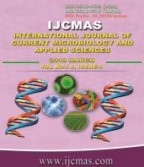


 National Academy of Agricultural Sciences (NAAS)
National Academy of Agricultural Sciences (NAAS)

|
PRINT ISSN : 2319-7692
Online ISSN : 2319-7706 Issues : 12 per year Publisher : Excellent Publishers Email : editorijcmas@gmail.com / submit@ijcmas.com Editor-in-chief: Dr.M.Prakash Index Copernicus ICV 2018: 95.39 NAAS RATING 2020: 5.38 |
A field experiment was conducted during Kharif 2015-16 in central research farm of Sam Higginbottom Institute of Agriculture Technology and Sciences, Allahabad to evaluate the field efficacy of certain chemicals against shoot and fruit borer on Brinjal. The occurrence of Shoot and Fruit Borer commenced from 34th standard week (August fourth week) with an average population of 0.90 larvae/plant. The shoot and fruit borer population increased and gradually reached its peak level of 6.56 larvae/plant at 40th standard week (October first week). There after declined trend was observed as temperature increased and temperature between 30-370C favoured the multiplication of shoot and fruit borer. The per cent population reduction of Brinjal shoot and fruit borer on third, seventh and fourteenth days after spraying revealed that Chlorantroniliprole found superior over all the treatments followed by Spinosad and Emamectin benzoate. Highest reduction in larval population (74.02%) was observed with Chlorantroniliprole. Minimum shoot damage of 6.72% and highest yield of 255.78q/ha was registered in Chlorantroniliprole. Highest Cost benefit ratio was recorded in Chlorantroniliprole (1:5.32) followed by Spinosad (1:4.32), Emamectin benzoate (1:5.10), Deltamethrin (1:4.24), Quinalphos (1:3.96), Carbosulfan (1:3.88) and Neem oil (1:3.71).
 |
 |
 |
 |
 |